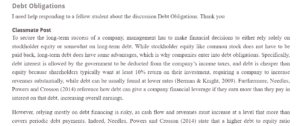Debt Obligations
Response to Classmate,
Great job with your post! However, I’m afraid I disagree with the statement that firms have to decide between debt and equity exclusively to achieve long-term success to achieve long-term success to achieve long-term success to achieve long-term success. In financing business operations, the capital structure enables firms to select the most optimal combination of debt and equity (Faccio & Xu, 2015). Through this structure, firms exploit the benefits of debt and equity. At the same time, this combination helps firms overcome the drawbacks of each of these techniques. An effective capital structure enables companies to access maximum funds at minimum costs. Additional benefits include a reduction of tax expenses through debt.
Would you like a genuine copy of “Debt Obligations essay”? C”contact us.
Additionally, I differ from your statement on investors requiring a minimum 10% return on capital invested. The returns paid out by firms depend on the dividend policy. Sometimes, companies may decide not to pay shareholders until the firm achieves a certain income level. Subsequently,firm’stors profit through capitfirm’sn on the firm’s stock. Ffirm’stance, Tesla has never paid dividends to its stock since its first initial offering in 2010. Similarly, Apple first paid out dividends in 2012 since the first initial offering in 1995 (Kaplan, 2018). Therefore, firms can choose not to pay their shareholders until they turn profitable.
The high debt ratio signals a red flag for the firm. High levels of debt predispose a firm to financial distress. First, the firm incurs significant expenditure in repaying the debt expense. Moreover, high debts result in inflexibility as firms must adhere to the debt covenants (Cole & Sokolyk, 2018). Highly leveraged firms risk bankruptcy, for instance, Lehman Brothers. In conclusion, I believe firms should strike a balance between debt and equity to enjoy the benefits presented by both.
Similar Post: Decision Making
References
Cole, R. A., & Sokolyk, T. (2018). Debt financing, survival, and growth of start-up firms. Journal of Corporate Finance, 50, 609-625.
Faccio, M., & Xu, J. (2015). Taxes and capital structure. Journal of Financial and Quantitative Analysis, 50(3), 277-300.
Kaplan, S. N. (2018). Are US Companies Too Short‐Term Oriented? Some Thoughts. Journal of Applied Corporate Finance, 30(4), 8-18.
ORDER A PLAGIARISM-FREE PAPER We’llWe’ll write everything froWe’llatch
Question
Debt ObligWe’lls
I need help responding to a fellow student about the discussion of Debt Obligations. Thank you

Debt ObliClassmate’sssmate’s Post
To secClassmate’sny’sa company’s long-term successssmate’sment, has to make financial decisions to either rely solely on stockholder equity or somewhat on long-term debt. While stockholder equity, like common stock, does not have to be paid back, long-term debt does have some advantages, which is why companies enter into debt obligations. Specifically, debt interest is allowed by the government to be dcompany’srom the company’s incomcompany’sand debt is cheaper than equity company shareholders typically want at least a 10% return on their investment, requiring a company to increase revenues substantially. In contrast, debt can usually be found at lower rates (Berman & Knight, 2009). Furthermore, Needles, Powers, and Crosson (2014) reference how debt can give a company financial leverage if they earn more than they pay in interest on that debt, increasing overall earnings.
However, relying primarily on debt financing is risky, as cash flow and revenues must increase at a level that more than covers periodic debt payments. Indeed, Needles, Powers, and Crosson (2014) state that a higher debt-to-equity ratio indicates a company is at a higher financial risk because it relies on debt financing. Thus, if a company cannot plan for maturity repayment successfully because they rely solely on debt financing, it will go bankrupt. So, companies should balance debt and equity for long-term financing. It comes down to operating with good intentions, free from greed. Because it is cheaper to engage in long-term debt financing, greed may drive management to decide to rely solely on debt. Yet, the risk/reward ratio is too high, as failing to increase revenues and cash flows will negatively affect all company stockholders, internally and externally. As we are reminded in 1 Timothy 6:9: “But those who desire to be rich fall into temptation, int a snare, into any sense”ess and harmful desires that”plunge people into ruin and destruction” (New International Version).
References
Berman, “. & Knight, J. (2009). When is “debt good? Harvard Business Review. Retrieved from hbr.org/2009/07/when-is-debt-good
Needles, B.E., Powers, M., & Crosson, S.V. (2014). Financial and managerial accounting. Mason, OH: South-Western/Cengage Learning

